Cabs C
Cabochons Index by Name
A B C D E F G H I J K L M N O P Q R S T U-V W X-Y-Z
Cal Silica (Rainbow Cal Silica)
See Rainbow Calsilica.
Calcite (Calcium Carbonate) - Mohs 3
Calcite is colorless or white, but impurities can make it just about any color - or it’s presence in other stones can make them paler versions of themselves. It is common in rocks & shells and it can be dissolved into or precipitated out of groundwater, playing a large part in geological formations such as caves, stalactites, and stalagmites. In jewelry cabochons it is more likely to be seen as an inclusion rather than to be cut as its own stone.
Calligraphy Stone - Mohs 7
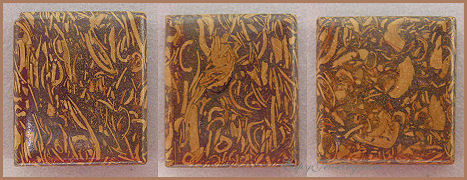
Once you see this stone, you will recognize it. It doesn’t get confused with other stones, but you will see it called many things. The most common names I see are Calligraphy Stone, Script Stone, and Elephant Skin Jasper. Additional names I have seen include Mariam, Indian Script Stone, Arabic Script Stone, and Elephant Jasper. The Indian I purchased it from called it Calligraphy Stone and I continue to use that name.
Any search will turn up a bunch of conflicting information from normally reliable sources. What everyone agrees on is that it comes from India, it is fossil material of some type, and the two different colors are of different hardnesses. There is no agreement as to whether it is fossilized grasses & reeds, fossilized shell, or some combination of both. Some sources say it is a jasper and other sources say it is not really a jasper but a mixture of shells, sand, and limonite.
Whatever it is, it is a natural stone with an unique, easily recognizable appearance.
Chalcedony (cal-sid-ney) - Mohs 6.5 - 7
GENERAL: One of the major sub-sets of quartz. Includes agate, petrified wood, chrysoprase, bloodstone, jasper, carnelian, moss agate, dendritic agate, sagenitec agate, and plume agate.
SPECIFIC: A bluish/whitish/greyish chalcedony variety. Natural chalcedony normally is NOT banded. If you see something called chalcedony with banding in it, it is normally dyed agate.
Chalcocite - Mohs 2.5 - 3
Chalcocite is a copper sulfide with a metallic grey-black color.
Chalcopyrite
Chalcopyrite is a copper iron sulfide and a copper ore. It is a metallic brassy gold color and you may see it called copper pyrite or fool’s gold. Apache Gold is chalcopyrite in black shist from Jerome, AZ.
Chalcopyrite is often intergrown in bornite, which is sold in chunks as Peacock Ore.
Chalcosiderite
See Turquoise.
Charoite - Mohs 5
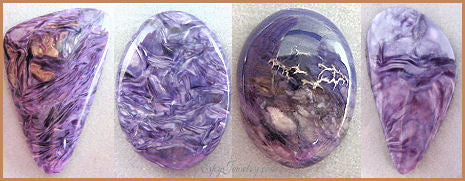
Charoite is a mineral and ranges from light purple with milky, pearly white swirls to a very dark purple, often with black markings. It is from Siberia, Russia.
Charoite may contain inclusions of the mineral tinaksite, which can be pink to salmon or goldish to brown in color. You can see a good example of this in the top left portion of the first stone.
Chatoyant
Chatoyancy is also called the cat’s eye effect. The internal structure of the stone causes a band of light to glide over the surface as the stone is moved.
Chrysocolla - Mohs 2.5 - 3.5, 6 - 8

Chrysocolla is a copper silicate. It ranges in color from blue to blue-green to green. It can be translucent or opaque.
Pure mineral chrysocolla is soft (2.5-3.5). Fortunately it likes to "agatize", intergrowing with quartz to form a harder (6-8) form of itself. The first picture is chrysocolla with cuprite. The remaining pictures are gem silica chrysocolla.
Druse chrysocolla is a crust of tiny quartz crystals forming over the agatized chrysocolla. The chrysocolla color completely wins in these rocks, thus they retain the name chrysocolla.
Gem silica chrysocolla, often shortened to gemsilica, is gem quality chrysocolla mixed with quartz (silica).
When the chrysocolla intergrows with clear sections of quartz, you may see it called Chrysocolla Quartz.
Apache Chrysocolla is chrysocolla with a colorful mixture of other copper minerals that may include malachite (green), shattuckite (blue), cuprite (red), and others.
Eilat Stone, from Eilat, Israel, is chrysocolla intergrown with turquoise and malachite.
Copper & Copper Minerals

Copper, the chemical element CU, is called native copper when found in its pure, free, metallic state. It has been mined forever and is fairly depleted in that state, so copper minerals are used as copper ores. Tons of minerals (more than 150) contain copper. A lot of them are very colorful, showing blues, greens, and reds, while others are not. You will often see cabochons referred to simply as copper minerals, meaning that it is a conglomeration of various copper minerals, that tend to like to grow together, with none of them being specifically identified. In the picture above, you can see the copper gleaming out from its host rock in the first image. The others are all examples of stones just labelled as copper minerals when purchased.
Copper ores are predominately oxidized ores or sulfide ores. Oxidized ores include minerals such as cuprite and tenorite. They can be reduced directly to metallic copper by heating with carbon in a furnace. Sulfide ores include minerals such as chalcopyrite and chalcocite. They require a more complex process, but are more important commercially.
Minerals with some of the highest copper contents are cuprite (red), chalcocite (black), covellite (blue), bornite (peacock ore), malachite (green), azurite (blue), chrysocolla (blue/green), and chalcopyrite (brassy). Other copper minerals you often see in jewelry cabochons include turquoise, tenorite (black), shattuckite (blue), cornetite (blue), and chalcosiderite (see turquoise). This is by no means a complete list of copper minerals, but gives you an idea of some of the things you might be seeing in a stone simply referred to as copper minerals.
Cornetite
Cornetite is a rare secondary copper mineral found in highly weathered oxidation zones of copper ores. It forms deep blue, green-blue to green crystals. The intense blue crystals can form a striking druse against malachite or chrysocolla.
Coral - Mohs 2.5 - 3
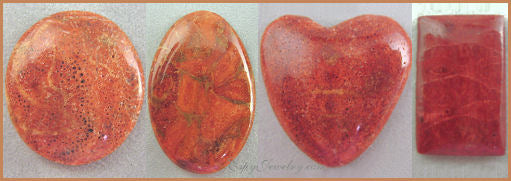
Sponge Coral Cabochons
Also see Indonesian Fossil Coral.
Coral is created by tiny marine organisms called polyps that normally live in colonies and secrete substances to form hard skeletons. These skeletal structures build over the course of generations. There are many different types of corals with different shapes and colors. Most coral used for jewelry grows in small, branch-like structures. Colors most traditionally used in jewelry have been corals (reds/orange-reds/pinks) and blacks. The value of coral depends primarily on its size, color, abundance or scarcity, and condition (whether collected live or dead).
Coral is soft and should be treated the same as pearls. Clean with a damp cloth. Do not soak in liquids. Avoid contact with chemicals. Apply perfumes/cosmetics/hairsprays prior to putting on jewelry, so it does not come into direct contact with the stone. And note - dyed corals may bleed! Test for colorfastness before wearing or avoid dyed materials.
"Precious coral" is a common way of referring to corals (many of which are sea fans) that historically have been highly valued for jewelry and art. "Semi-precious coral" gets applied to other corals used primarily for jewelry. Their abundance and high porosity give them less value.
Jewelry corals don’t seem to be part of large coral reefs, but more low-growing, coral "forests". The "precious corals" that have been traditionally used for jewelry all seem to have been harvested primarily by dredging. It is an operation that just basically pulls everything up from the ocean floor without discrimination. The impact is profound. Fortunately, dredging is being phased out, in favor of more discriminatory collection methods using scuba divers and submersibles. And many of the people I have purchased sponge coral/apple coral from make a point of saying that it is material that was dis-entangled from fishing nets, which would imply that the nets snagged the coral and broke off pieces rather than upending the entire colony.
As demand for "precious coral" has exceded supply, it has become scarcer and more expensive. "Semi precious" varieties have been pressed into use, primarily sponge coral (also sold as apple coral - highly porous, stabilized prior to use) and dyed bamboo coral (natural color white, dyed red). Because coral is popular and can be expensive, it gets imitated. Besides total imitations like plastics, there is reconstituted coral. It starts from natural coral fragments that are pulverized into a powder, soaked in binding agents, then pressed into a solid mass to be re-cut. The binding agents normally include dye to create a vivid red color.
Some notable jewelry corals include -
Corallium - Traditional Precious Coral - Mohs 3.5
These corals/sea fans are dense and durable, with intensely colored skeletons of red, orange-red (coral), peach, pink, and white that take a high polish. They grow as branching, tree-like structures and the colors are due to organic carotenoid pigments. Their solid texture have parallel longitudinal striations on the surface of the coral but do not show visible holes, other than clusters of pin points remnant of the central canal. Historically, the Mediterranean Sea has been an important source of red coral.
Sponge Coral (Melithaea Ochracea)
Semi precious, sponge coral is a term used for coral with visible pores, like a sponge. While calcareous, it does not have a dense structure and must be stabilized before it will take a polish. Found mainly in the South China sea, these corals/sea fans are normally orange-red with brown markings (also sold as "Apple Coral"), but they also occur in a grayish blue color.
The picture at the top of the page is sponge coral. I assume sponge coral is stabilized. Orangey-red, like the first three, is probably a natural color, especially if you see brown markings in it. I assume the really red reds, like the last one, have been color enhanced, probably through a dye added to the stabilizer. I don’t think any of the cabochons I have purchased are from reconstituted material, but I just do not know for sure.
Gold Coral
Gold coral is considered precious coral. Specific corals seem to be in the genera narella, calyptrophora, and callogorgia. They are pretty, orange to reddish orange corals with protien skeletons abundantly infused with calcite spicules.
Bamboo Coral
Semi precious bamboo coral (sea bamboo) grows in segmented branches that resemble bamboo stalks. It has a flexible skeleton consisting of calcium carbonate segments interspersed with protein (gorgonin) joints. Natural colors seem to be limited to white/beige/tan sections with black to dark brown bands. Red bamboo coral on the market has been dyed.
Helioporacea = Coenothecalia - Blue Corals
Semi precious, porous coral where the blue color is caused by iron salts in the calcium carbonate skeleton.
Antipatharia - Thorny Black Coral
Precious Coral. Although its living tissue is brilliantly colored, its skeleton is a distinctive black or dark brown color and polishes to a high shine. Tiny spines (thorns) cover the surface of the skeleton which is made of protein - there are no calcareous components.
Gold Coral, Black Coral
Precious gold (Gerardia Species) and black (Gerardia savaglia) corals of the genus gerardia produce protein skeletons. Although capable of forming their own skeleton, instead they usually live on the surface of gorgonian coral or other invertebrate. The invasion takes place on both living & dead colonies, which are progressively destroyed by the gerardia.
One marketed variety is Hawaiian Gold Coral (Gerardia Species). The color may vary from a sandy beige to almost black and can display interesting patterns. It is also chatoyant, having a mysterious moving inner light.
For more information, also visit the International Colored Gemstone Assoc.
Covellite - Mohs 1.5 - 2
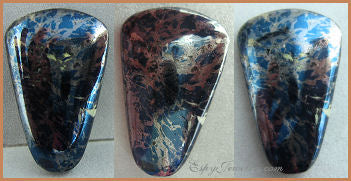
Covellite is a deep metallic blue copper mineral. Cut cabochons normally have a scattering of shiny metallic pyrite.
The pictures above are all of the same stone. It is a very dark, very shiny blue, probably best represented in the first image. I shone some light on it so you could see the pyrite inclusions, but it really normally shows as a dark cobalt blue and is hard to distinquish the pyrite from the covellite. You will note it also has some white inclusions, probably calcite.
Cuprite (ruby copper, red copper) - Mohs 3.5
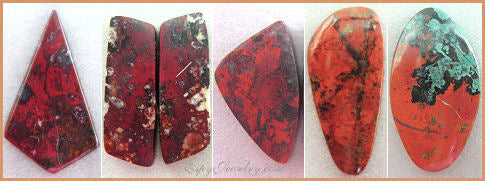
Cuprite is a copper ore and has two unusual varieties, chalcotrichite and tile ore. They are either a dark, really red, red or an orange red often referred to as brick-red.
Cuprite is dark red. You don’t see it as much by itself as intermixed with other copper minerals such as azurite and malachite. When cut as a cabochon, cuprite often has white, black, or copper inclusions. Although rare, it can occur in crystals large enough to be faceted. They are definitely collector’s items, said to mix the color of garnet with the brilliance of diamond.
Chalcotrichite, also called plush copper ore, is a fibrous form of cuprite. The name comes from the Greek, meaning "hairy copper" and it consists of thin fibrous sprays or mats of hair-like crystals. It has a rich carmine color and a silky lustre.
Tile ore is a orangish red massive variety of cuprite that is formed by the alteration of chalcopyrite. It is usually found with malachite or other secondary copper minerals and often has inclusions of dark hematite or limonite.
A great combination coming out of the Millpillas Mine in Sonora, Mexico is called Sonora Sunrise (or Sonoran Sunrise, Sonora Sunset, or Sonoran Sunset, just depending on who is writing it). I’m told that the mine opened in 2006 and that rather than being an open pit mine like most copper mines, they have tunnelled 1000 feet down. The material is a combination of chrysocolla (green, blue-green), cuprite (red), tile ore (orangey red), and tenorite (black). For me, it is not sunrise without the red though, so I’ve included it here with cuprite. The last two stones in the above picture were cut from Sonora Sunrise.
Cabochons Index by Name
A B C D E F G H I J K L M N O P Q R S T U-V W X-Y-Z
A B C D E F G H I J K L M N O P Q R S T U-V W X-Y-Z
C
Cal Silica (Rainbow Cal Silica)
See Rainbow Calsilica.
Calcite (Calcium Carbonate) - Mohs 3
Calcite is colorless or white, but impurities can make it just about any color - or it’s presence in other stones can make them paler versions of themselves. It is common in rocks & shells and it can be dissolved into or precipitated out of groundwater, playing a large part in geological formations such as caves, stalactites, and stalagmites. In jewelry cabochons it is more likely to be seen as an inclusion rather than to be cut as its own stone.
Calligraphy Stone - Mohs 7

Once you see this stone, you will recognize it. It doesn’t get confused with other stones, but you will see it called many things. The most common names I see are Calligraphy Stone, Script Stone, and Elephant Skin Jasper. Additional names I have seen include Mariam, Indian Script Stone, Arabic Script Stone, and Elephant Jasper. The Indian I purchased it from called it Calligraphy Stone and I continue to use that name.
Any search will turn up a bunch of conflicting information from normally reliable sources. What everyone agrees on is that it comes from India, it is fossil material of some type, and the two different colors are of different hardnesses. There is no agreement as to whether it is fossilized grasses & reeds, fossilized shell, or some combination of both. Some sources say it is a jasper and other sources say it is not really a jasper but a mixture of shells, sand, and limonite.
Whatever it is, it is a natural stone with an unique, easily recognizable appearance.
Chalcedony (cal-sid-ney) - Mohs 6.5 - 7
GENERAL: One of the major sub-sets of quartz. Includes agate, petrified wood, chrysoprase, bloodstone, jasper, carnelian, moss agate, dendritic agate, sagenitec agate, and plume agate.
SPECIFIC: A bluish/whitish/greyish chalcedony variety. Natural chalcedony normally is NOT banded. If you see something called chalcedony with banding in it, it is normally dyed agate.
Chalcocite - Mohs 2.5 - 3
Chalcocite is a copper sulfide with a metallic grey-black color.
Chalcopyrite
Chalcopyrite is a copper iron sulfide and a copper ore. It is a metallic brassy gold color and you may see it called copper pyrite or fool’s gold. Apache Gold is chalcopyrite in black shist from Jerome, AZ.
Chalcopyrite is often intergrown in bornite, which is sold in chunks as Peacock Ore.
Chalcosiderite
See Turquoise.
Charoite - Mohs 5

Charoite is a mineral and ranges from light purple with milky, pearly white swirls to a very dark purple, often with black markings. It is from Siberia, Russia.
Charoite may contain inclusions of the mineral tinaksite, which can be pink to salmon or goldish to brown in color. You can see a good example of this in the top left portion of the first stone.
Chatoyant
Chatoyancy is also called the cat’s eye effect. The internal structure of the stone causes a band of light to glide over the surface as the stone is moved.
Chrysocolla - Mohs 2.5 - 3.5, 6 - 8

Chrysocolla is a copper silicate. It ranges in color from blue to blue-green to green. It can be translucent or opaque.
Pure mineral chrysocolla is soft (2.5-3.5). Fortunately it likes to "agatize", intergrowing with quartz to form a harder (6-8) form of itself. The first picture is chrysocolla with cuprite. The remaining pictures are gem silica chrysocolla.
Druse chrysocolla is a crust of tiny quartz crystals forming over the agatized chrysocolla. The chrysocolla color completely wins in these rocks, thus they retain the name chrysocolla.
Gem silica chrysocolla, often shortened to gemsilica, is gem quality chrysocolla mixed with quartz (silica).
When the chrysocolla intergrows with clear sections of quartz, you may see it called Chrysocolla Quartz.
Apache Chrysocolla is chrysocolla with a colorful mixture of other copper minerals that may include malachite (green), shattuckite (blue), cuprite (red), and others.
Eilat Stone, from Eilat, Israel, is chrysocolla intergrown with turquoise and malachite.
Copper & Copper Minerals

Copper, the chemical element CU, is called native copper when found in its pure, free, metallic state. It has been mined forever and is fairly depleted in that state, so copper minerals are used as copper ores. Tons of minerals (more than 150) contain copper. A lot of them are very colorful, showing blues, greens, and reds, while others are not. You will often see cabochons referred to simply as copper minerals, meaning that it is a conglomeration of various copper minerals, that tend to like to grow together, with none of them being specifically identified. In the picture above, you can see the copper gleaming out from its host rock in the first image. The others are all examples of stones just labelled as copper minerals when purchased.
Copper ores are predominately oxidized ores or sulfide ores. Oxidized ores include minerals such as cuprite and tenorite. They can be reduced directly to metallic copper by heating with carbon in a furnace. Sulfide ores include minerals such as chalcopyrite and chalcocite. They require a more complex process, but are more important commercially.
Minerals with some of the highest copper contents are cuprite (red), chalcocite (black), covellite (blue), bornite (peacock ore), malachite (green), azurite (blue), chrysocolla (blue/green), and chalcopyrite (brassy). Other copper minerals you often see in jewelry cabochons include turquoise, tenorite (black), shattuckite (blue), cornetite (blue), and chalcosiderite (see turquoise). This is by no means a complete list of copper minerals, but gives you an idea of some of the things you might be seeing in a stone simply referred to as copper minerals.
Cornetite
Cornetite is a rare secondary copper mineral found in highly weathered oxidation zones of copper ores. It forms deep blue, green-blue to green crystals. The intense blue crystals can form a striking druse against malachite or chrysocolla.
Coral - Mohs 2.5 - 3

Sponge Coral Cabochons
Also see Indonesian Fossil Coral.
Coral is created by tiny marine organisms called polyps that normally live in colonies and secrete substances to form hard skeletons. These skeletal structures build over the course of generations. There are many different types of corals with different shapes and colors. Most coral used for jewelry grows in small, branch-like structures. Colors most traditionally used in jewelry have been corals (reds/orange-reds/pinks) and blacks. The value of coral depends primarily on its size, color, abundance or scarcity, and condition (whether collected live or dead).
Coral is soft and should be treated the same as pearls. Clean with a damp cloth. Do not soak in liquids. Avoid contact with chemicals. Apply perfumes/cosmetics/hairsprays prior to putting on jewelry, so it does not come into direct contact with the stone. And note - dyed corals may bleed! Test for colorfastness before wearing or avoid dyed materials.
"Precious coral" is a common way of referring to corals (many of which are sea fans) that historically have been highly valued for jewelry and art. "Semi-precious coral" gets applied to other corals used primarily for jewelry. Their abundance and high porosity give them less value.
Jewelry corals don’t seem to be part of large coral reefs, but more low-growing, coral "forests". The "precious corals" that have been traditionally used for jewelry all seem to have been harvested primarily by dredging. It is an operation that just basically pulls everything up from the ocean floor without discrimination. The impact is profound. Fortunately, dredging is being phased out, in favor of more discriminatory collection methods using scuba divers and submersibles. And many of the people I have purchased sponge coral/apple coral from make a point of saying that it is material that was dis-entangled from fishing nets, which would imply that the nets snagged the coral and broke off pieces rather than upending the entire colony.
As demand for "precious coral" has exceded supply, it has become scarcer and more expensive. "Semi precious" varieties have been pressed into use, primarily sponge coral (also sold as apple coral - highly porous, stabilized prior to use) and dyed bamboo coral (natural color white, dyed red). Because coral is popular and can be expensive, it gets imitated. Besides total imitations like plastics, there is reconstituted coral. It starts from natural coral fragments that are pulverized into a powder, soaked in binding agents, then pressed into a solid mass to be re-cut. The binding agents normally include dye to create a vivid red color.
Some notable jewelry corals include -
Corallium - Traditional Precious Coral - Mohs 3.5
These corals/sea fans are dense and durable, with intensely colored skeletons of red, orange-red (coral), peach, pink, and white that take a high polish. They grow as branching, tree-like structures and the colors are due to organic carotenoid pigments. Their solid texture have parallel longitudinal striations on the surface of the coral but do not show visible holes, other than clusters of pin points remnant of the central canal. Historically, the Mediterranean Sea has been an important source of red coral.
Sponge Coral (Melithaea Ochracea)
Semi precious, sponge coral is a term used for coral with visible pores, like a sponge. While calcareous, it does not have a dense structure and must be stabilized before it will take a polish. Found mainly in the South China sea, these corals/sea fans are normally orange-red with brown markings (also sold as "Apple Coral"), but they also occur in a grayish blue color.
The picture at the top of the page is sponge coral. I assume sponge coral is stabilized. Orangey-red, like the first three, is probably a natural color, especially if you see brown markings in it. I assume the really red reds, like the last one, have been color enhanced, probably through a dye added to the stabilizer. I don’t think any of the cabochons I have purchased are from reconstituted material, but I just do not know for sure.
Gold Coral
Gold coral is considered precious coral. Specific corals seem to be in the genera narella, calyptrophora, and callogorgia. They are pretty, orange to reddish orange corals with protien skeletons abundantly infused with calcite spicules.
Bamboo Coral
Semi precious bamboo coral (sea bamboo) grows in segmented branches that resemble bamboo stalks. It has a flexible skeleton consisting of calcium carbonate segments interspersed with protein (gorgonin) joints. Natural colors seem to be limited to white/beige/tan sections with black to dark brown bands. Red bamboo coral on the market has been dyed.
Helioporacea = Coenothecalia - Blue Corals
Semi precious, porous coral where the blue color is caused by iron salts in the calcium carbonate skeleton.
Antipatharia - Thorny Black Coral
Precious Coral. Although its living tissue is brilliantly colored, its skeleton is a distinctive black or dark brown color and polishes to a high shine. Tiny spines (thorns) cover the surface of the skeleton which is made of protein - there are no calcareous components.
Gold Coral, Black Coral
Precious gold (Gerardia Species) and black (Gerardia savaglia) corals of the genus gerardia produce protein skeletons. Although capable of forming their own skeleton, instead they usually live on the surface of gorgonian coral or other invertebrate. The invasion takes place on both living & dead colonies, which are progressively destroyed by the gerardia.
One marketed variety is Hawaiian Gold Coral (Gerardia Species). The color may vary from a sandy beige to almost black and can display interesting patterns. It is also chatoyant, having a mysterious moving inner light.
For more information, also visit the International Colored Gemstone Assoc.
Covellite - Mohs 1.5 - 2

Covellite is a deep metallic blue copper mineral. Cut cabochons normally have a scattering of shiny metallic pyrite.
The pictures above are all of the same stone. It is a very dark, very shiny blue, probably best represented in the first image. I shone some light on it so you could see the pyrite inclusions, but it really normally shows as a dark cobalt blue and is hard to distinquish the pyrite from the covellite. You will note it also has some white inclusions, probably calcite.
Cuprite (ruby copper, red copper) - Mohs 3.5

Cuprite is a copper ore and has two unusual varieties, chalcotrichite and tile ore. They are either a dark, really red, red or an orange red often referred to as brick-red.
Cuprite is dark red. You don’t see it as much by itself as intermixed with other copper minerals such as azurite and malachite. When cut as a cabochon, cuprite often has white, black, or copper inclusions. Although rare, it can occur in crystals large enough to be faceted. They are definitely collector’s items, said to mix the color of garnet with the brilliance of diamond.
Chalcotrichite, also called plush copper ore, is a fibrous form of cuprite. The name comes from the Greek, meaning "hairy copper" and it consists of thin fibrous sprays or mats of hair-like crystals. It has a rich carmine color and a silky lustre.
Tile ore is a orangish red massive variety of cuprite that is formed by the alteration of chalcopyrite. It is usually found with malachite or other secondary copper minerals and often has inclusions of dark hematite or limonite.
A great combination coming out of the Millpillas Mine in Sonora, Mexico is called Sonora Sunrise (or Sonoran Sunrise, Sonora Sunset, or Sonoran Sunset, just depending on who is writing it). I’m told that the mine opened in 2006 and that rather than being an open pit mine like most copper mines, they have tunnelled 1000 feet down. The material is a combination of chrysocolla (green, blue-green), cuprite (red), tile ore (orangey red), and tenorite (black). For me, it is not sunrise without the red though, so I’ve included it here with cuprite. The last two stones in the above picture were cut from Sonora Sunrise.
Cabochons Index by Name
A B C D E F G H I J K L M N O P Q R S T U-V W X-Y-Z
 Unique, One-of-a-Kind Settings for Unique, One-of-a-Kind Stones
Unique, One-of-a-Kind Settings for Unique, One-of-a-Kind Stones